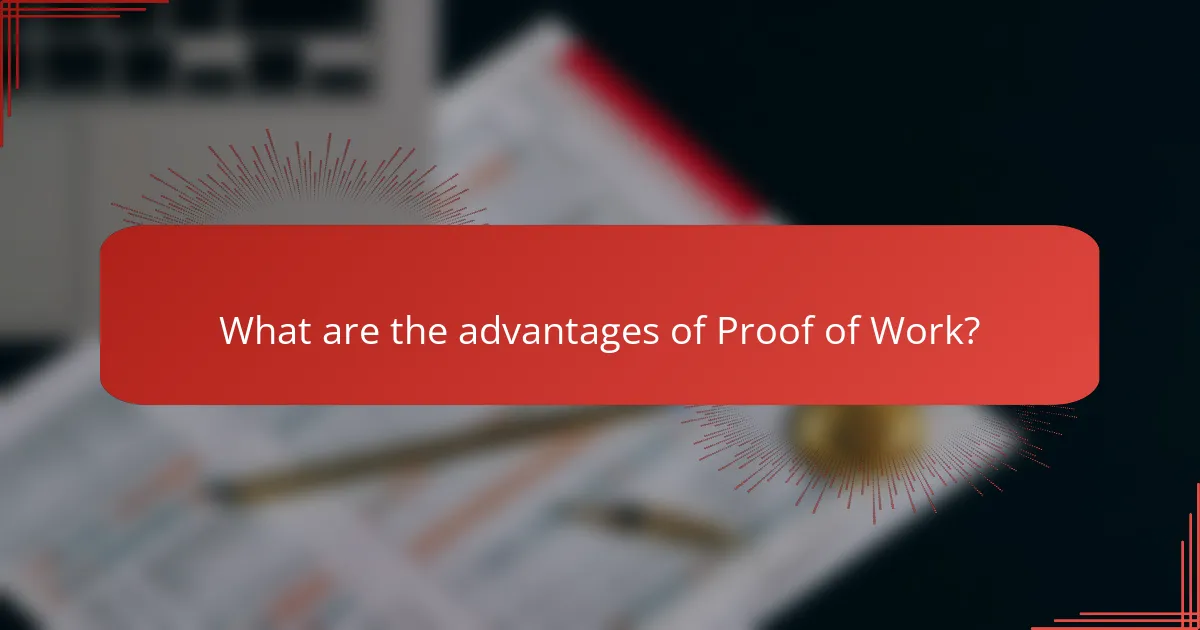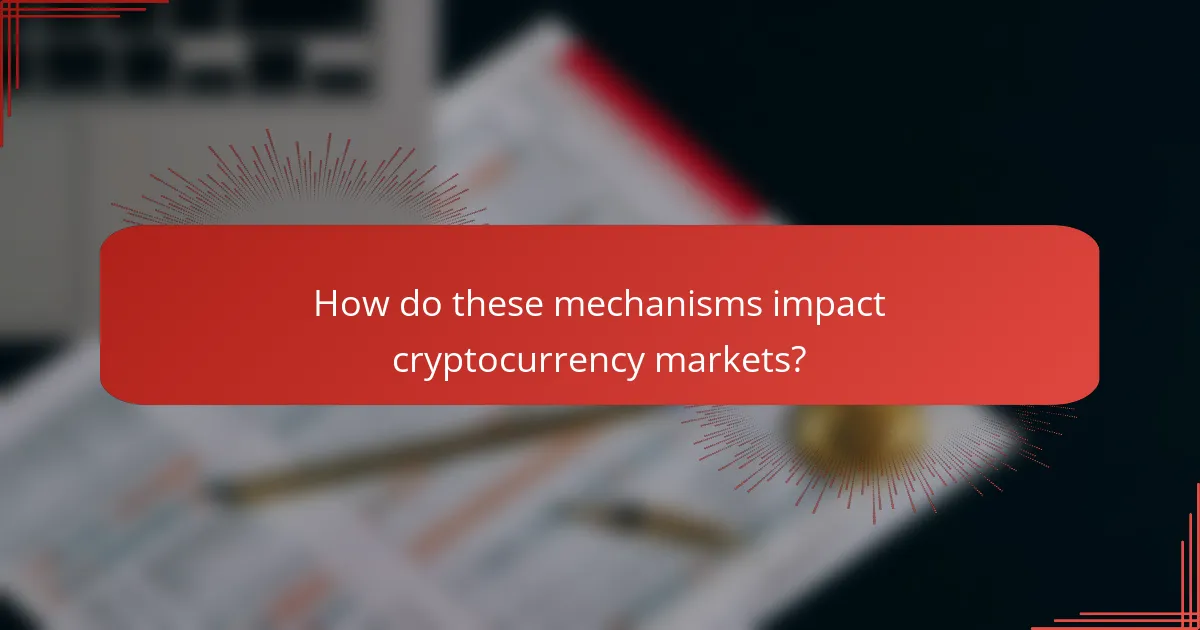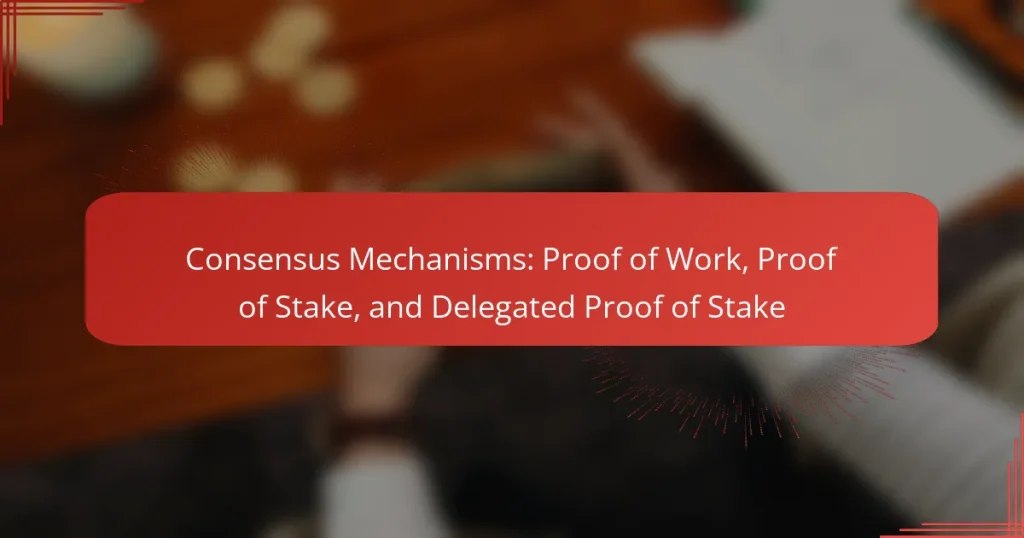Consensus mechanisms are essential for maintaining the integrity and security of blockchain networks, with Proof of Work (PoW), Proof of Stake (PoS), and Delegated Proof of Stake (DPoS) being the most prominent. PoW relies on computational power to validate transactions, while PoS selects validators based on their coin holdings. DPoS enhances this process by allowing stakeholders to elect delegates, promoting efficiency and scalability in a decentralized manner.

What are the key differences between Proof of Work and Proof of Stake?
The key differences between Proof of Work (PoW) and Proof of Stake (PoS) lie in their mechanisms for validating transactions and securing the network. PoW relies on computational power to solve complex mathematical problems, while PoS selects validators based on the number of coins they hold and are willing to “stake.”
Energy consumption comparison
Proof of Work is known for its high energy consumption due to the extensive computational power required for mining. This can lead to significant electricity costs, often measured in megawatt-hours per transaction, making it less environmentally friendly.
In contrast, Proof of Stake consumes far less energy since it does not require extensive computational resources. Validators are chosen based on their stake, resulting in a more energy-efficient process that can reduce overall carbon footprints significantly.
Security mechanisms
Proof of Work secures the network by making it costly and time-consuming to alter transaction history, as attackers would need to control a majority of the computational power. This makes it difficult for malicious actors to compromise the network.
Proof of Stake uses a different approach, where the likelihood of being chosen to validate transactions is proportional to the amount of cryptocurrency held. This mechanism discourages attacks since validators risk losing their staked coins if they act maliciously, providing a different layer of security.
Transaction speed
Transaction speeds in Proof of Work networks can vary widely, often taking several minutes to confirm transactions due to the time needed for miners to solve complex problems. This can lead to delays, especially during peak usage times.
Proof of Stake generally offers faster transaction speeds, often confirming transactions in seconds or low tens of seconds. The reduced validation time is due to the absence of intensive computational tasks, allowing for quicker consensus.
Decentralization levels
Decentralization in Proof of Work can be compromised as mining power tends to concentrate in regions with cheaper electricity, leading to mining pools that control significant portions of the network. This can create vulnerabilities and reduce the overall decentralization.
Proof of Stake promotes decentralization by allowing more participants to become validators without the need for expensive hardware. However, it can still face challenges if wealth concentration occurs, as those with larger stakes have more influence over the network.

How does Delegated Proof of Stake work?
Delegated Proof of Stake (DPoS) is a consensus mechanism where stakeholders elect delegates to validate transactions and maintain the blockchain. This system aims to enhance efficiency and scalability while ensuring that the network remains decentralized.
Voting process
In DPoS, token holders vote for a limited number of delegates, often referred to as “witnesses” or “block producers.” Each voter typically has a number of votes proportional to their stake, allowing them to support multiple candidates. The delegates with the highest votes are then responsible for producing blocks and confirming transactions.
This voting process can be dynamic, allowing stakeholders to change their votes as needed, which encourages delegates to perform well to retain support. The voting period may vary, but it often lasts from a few days to a couple of weeks, depending on the specific blockchain protocol.
Node selection criteria
Node selection in DPoS is primarily based on the number of votes received from the community. Delegates must demonstrate reliability, performance, and transparency to gain and maintain voter trust. Some networks also impose additional criteria, such as technical capabilities, uptime, and community engagement.
In many cases, the top delegates are elected for a fixed term, which can range from weeks to months. This term structure incentivizes delegates to act in the best interest of the network to secure re-election.
Benefits over traditional PoS
DPoS offers several advantages compared to traditional Proof of Stake (PoS) systems. One significant benefit is increased transaction throughput, as fewer nodes are responsible for validating transactions, allowing for faster block times. This can lead to improved user experience in applications built on the blockchain.
Additionally, DPoS enhances decentralization by allowing a broader range of participants to influence network governance through voting. This system can reduce the risk of centralization that sometimes occurs in PoS, where large stakeholders may dominate decision-making. Overall, DPoS aims to balance efficiency with community involvement, creating a more responsive and adaptable network.

What are the advantages of Proof of Work?
Proof of Work (PoW) offers several advantages, primarily centered around its robust security and decentralized nature. By requiring computational effort to validate transactions, PoW helps prevent malicious activities and ensures that network participants are invested in the system’s integrity.
Security strength
The security strength of Proof of Work is one of its most significant advantages. The extensive computational power required to solve cryptographic puzzles makes it exceedingly difficult for attackers to manipulate the blockchain. For instance, a successful attack would necessitate controlling over 50% of the network’s hashing power, which is often prohibitively expensive and logistically challenging.
Additionally, the energy and resources expended in mining serve as a deterrent against fraudulent activities. This high cost of attack reinforces the trustworthiness of the network, as potential adversaries must weigh the risks against the potential rewards of compromising the system.
Network stability
Proof of Work contributes to network stability by creating a predictable and secure environment for transactions. The time it takes to mine a block is generally consistent, often ranging from 10 minutes to an hour, depending on the network’s design. This regularity helps maintain a steady flow of transactions and reduces the likelihood of network congestion.
Moreover, the decentralized nature of PoW means that no single entity controls the network, which enhances its resilience. If one miner goes offline or attempts to act maliciously, the network can continue to function normally, as other miners will step in to validate transactions and maintain the blockchain’s integrity.

What are the advantages of Proof of Stake?
Proof of Stake (PoS) offers several advantages over traditional consensus mechanisms like Proof of Work (PoW), primarily through reduced energy consumption and enhanced scalability. By allowing validators to create new blocks based on the number of coins they hold and are willing to “stake,” PoS promotes a more efficient and environmentally friendly approach to blockchain security.
Lower energy costs
One of the most significant advantages of Proof of Stake is its lower energy costs compared to Proof of Work. PoW requires substantial computational power and energy to solve complex mathematical problems, leading to high electricity consumption. In contrast, PoS validators are chosen based on their stake, which eliminates the need for energy-intensive mining operations.
This reduction in energy use not only lowers operational costs for blockchain networks but also makes PoS a more sustainable option. For instance, networks using PoS can operate with energy consumption that is a fraction of that required by PoW systems, often measured in kilowatt-hours rather than megawatt-hours.
Increased scalability
Proof of Stake enhances scalability by allowing for faster transaction processing and higher throughput. Since PoS does not rely on energy-intensive computations, it can handle a larger number of transactions per second. This capability is crucial for applications that require quick confirmations, such as decentralized finance (DeFi) platforms.
Additionally, PoS networks can implement sharding and other scaling solutions more effectively, further increasing their capacity. For example, some PoS blockchains can achieve transaction finality in seconds, compared to the longer times often seen in PoW systems, which can take minutes or longer due to their consensus mechanisms.

What are the challenges of Delegated Proof of Stake?
Delegated Proof of Stake (DPoS) faces several challenges, primarily related to centralization and voter engagement. These issues can impact the effectiveness and fairness of the consensus mechanism, affecting the overall health of the blockchain network.
Centralization risks
In DPoS, a small group of delegates is elected to validate transactions and maintain the network, which can lead to centralization. This concentration of power may result in a few entities having disproportionate influence over the blockchain, potentially undermining its decentralized nature.
For example, if a few large stakeholders dominate the voting process, they can prioritize their interests over the community’s. This centralization can lead to governance issues and reduced trust among users, as decisions may not reflect the broader network’s needs.
Voter apathy
Voter apathy is a significant challenge in DPoS systems, where many token holders may not participate in the voting process. This lack of engagement can stem from a belief that their individual vote has little impact or from a lack of understanding of the voting mechanism.
To combat voter apathy, networks can implement educational initiatives and incentivize participation through rewards. Encouraging active involvement from the community is crucial for ensuring that the elected delegates truly represent the interests of the broader user base.

How do these mechanisms impact cryptocurrency markets?
Consensus mechanisms like Proof of Work (PoW), Proof of Stake (PoS), and Delegated Proof of Stake (DPoS) significantly influence cryptocurrency markets by affecting transaction speeds, security, and overall market stability. Each mechanism has unique characteristics that can lead to varying levels of volatility and investor confidence.
Market volatility
Market volatility in cryptocurrencies is often influenced by the consensus mechanism employed. Proof of Work, which requires significant computational power, can lead to higher transaction costs and slower confirmation times during peak demand, causing price fluctuations. In contrast, Proof of Stake and Delegated Proof of Stake generally offer faster transaction speeds and lower fees, which can contribute to a more stable market environment.
For example, during periods of high demand, PoW networks like Bitcoin may experience significant delays, leading to panic selling and increased volatility. On the other hand, PoS networks like Ethereum 2.0 can handle more transactions quickly, potentially reducing price swings. Investors should be aware of these dynamics when choosing which cryptocurrencies to trade or hold.
To mitigate the effects of volatility, consider diversifying your portfolio across different consensus mechanisms. This strategy can help balance risks and capitalize on the strengths of each type, leading to a more resilient investment approach.


